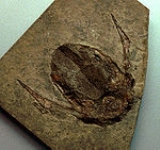
Bothriolepis
Encyclopedia
Bothriolepis was the most successful genus
of antiarch placoderms, if not the most successful genus of any placoderm, with over 100 species found on every continent.
(387–360 million years ago). Because the fossils are found in freshwater sediments, Bothriolepis is presumed to have spent most of its life in freshwater
rivers and lakes, but was probably able to enter salt water
as well because its range appeared to have corresponded with the Devonian continental coastlines. Many paleontologists hypothesize that they were anadromous, that is, they lived most of their lives in saltwater, and returned to freshwater only to breed, similar to salmon
. Its box-like body was enclosed in armor plates, providing protection from predators.
It had a heavily armoured head fused with the thoracic shield. It had a long pair of spine-like pectoral fins, jointed at the base, and again a little more than half way along. These spike-like fins were probably used to lift the body clear off the bottom; its heavy armor would have made it sink quickly as soon as it lost forward momentum.Bothriolepis had a peculiar spiral, sediment-filled gut and probably grubbed in the mud. It may also have used its pectoral fins to throw sediment (mud, sand or otherwise) over itself.
 There are two openings through its head: a keyhole opening along the midline on the upper side for the eyes and nostrils and a mouth on the lower side near the front. It also had a special feature on its skull, a separate partition of bone below the opening for the eyes and nostrils enclosing the nasal capsules called a preorbital recess. It had gills in addition to a pair of pouches off the esophagus
There are two openings through its head: a keyhole opening along the midline on the upper side for the eyes and nostrils and a mouth on the lower side near the front. It also had a special feature on its skull, a separate partition of bone below the opening for the eyes and nostrils enclosing the nasal capsules called a preorbital recess. It had gills in addition to a pair of pouches off the esophagus
that, according to scientific speculation, may have functioned as lungs. It has been hypothesized that these lungs, coupled with the jointed arms and rigid, supportive skeleton, would allow Bothriolepis to travel on land. Bothriolepis had a slender fish-like tail that extended behind the heavily armored portion, which is unfortunately rarely preserved in fossils.
Genus
In biology, a genus is a low-level taxonomic rank used in the biological classification of living and fossil organisms, which is an example of definition by genus and differentia...
of antiarch placoderms, if not the most successful genus of any placoderm, with over 100 species found on every continent.
Description and palaeobiology
Bothropelpis was a small benthic freshwater detrivore, around 30 centimetres (11.8 in) long, which lived in the Middle and Late DevonianDevonian
The Devonian is a geologic period and system of the Paleozoic Era spanning from the end of the Silurian Period, about 416.0 ± 2.8 Mya , to the beginning of the Carboniferous Period, about 359.2 ± 2.5 Mya...
(387–360 million years ago). Because the fossils are found in freshwater sediments, Bothriolepis is presumed to have spent most of its life in freshwater
Freshwater
Fresh water is naturally occurring water on the Earth's surface in ice sheets, ice caps, glaciers, bogs, ponds, lakes, rivers and streams, and underground as groundwater in aquifers and underground streams. Fresh water is generally characterized by having low concentrations of dissolved salts and...
rivers and lakes, but was probably able to enter salt water
Seawater
Seawater is water from a sea or ocean. On average, seawater in the world's oceans has a salinity of about 3.5% . This means that every kilogram of seawater has approximately of dissolved salts . The average density of seawater at the ocean surface is 1.025 g/ml...
as well because its range appeared to have corresponded with the Devonian continental coastlines. Many paleontologists hypothesize that they were anadromous, that is, they lived most of their lives in saltwater, and returned to freshwater only to breed, similar to salmon
Salmon
Salmon is the common name for several species of fish in the family Salmonidae. Several other fish in the same family are called trout; the difference is often said to be that salmon migrate and trout are resident, but this distinction does not strictly hold true...
. Its box-like body was enclosed in armor plates, providing protection from predators.
It had a heavily armoured head fused with the thoracic shield. It had a long pair of spine-like pectoral fins, jointed at the base, and again a little more than half way along. These spike-like fins were probably used to lift the body clear off the bottom; its heavy armor would have made it sink quickly as soon as it lost forward momentum.Bothriolepis had a peculiar spiral, sediment-filled gut and probably grubbed in the mud. It may also have used its pectoral fins to throw sediment (mud, sand or otherwise) over itself.

Esophagus
The esophagus is an organ in vertebrates which consists of a muscular tube through which food passes from the pharynx to the stomach. During swallowing, food passes from the mouth through the pharynx into the esophagus and travels via peristalsis to the stomach...
that, according to scientific speculation, may have functioned as lungs. It has been hypothesized that these lungs, coupled with the jointed arms and rigid, supportive skeleton, would allow Bothriolepis to travel on land. Bothriolepis had a slender fish-like tail that extended behind the heavily armored portion, which is unfortunately rarely preserved in fossils.
External links
- Mikko's Phylogeny ArchiveMikko's Phylogeny ArchiveMikko's Phylogeny Archive is an amateur paleontology website maintained by Mikko Haaramo, a student at the University of Helsinki's Department of Geology, Division of Geology and Palaeontology....
Bothriolepis

